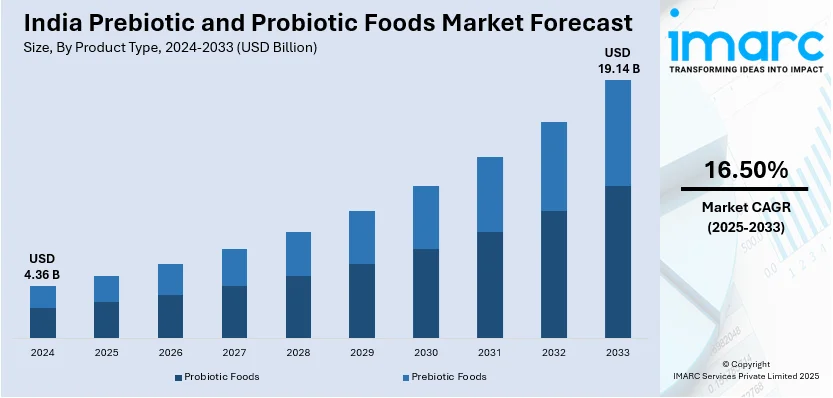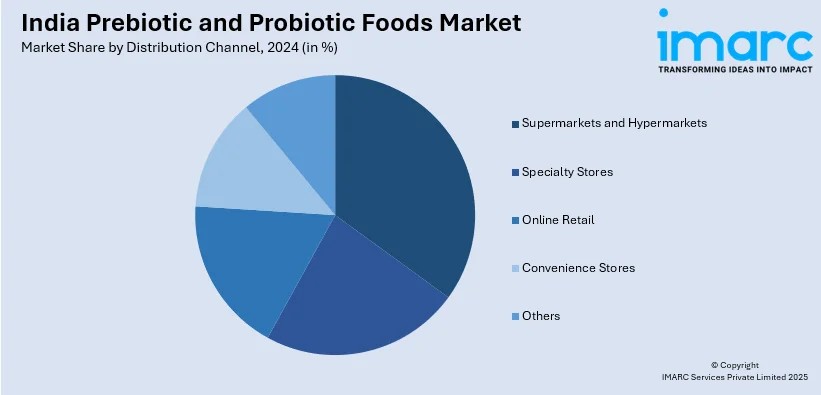
India Prebiotic and Probiotic Foods Market Size, Share, Trends and Forecast by Product Type, Form, Distribution Channel, End User, and Region, 2025-2033
India Prebiotic and Probiotic Foods Market Size and Share:
The India prebiotic and probiotic foods market size reached USD 4.36 Billion in 2024. Looking forward, IMARC Group expects the market to reach USD 19.14 Billion by 2033, exhibiting a growth rate (CAGR) of 16.50% during 2025-2033. The market is driven by rising health awareness, increasing digestive and immune health concerns, and the growing preference for functional foods. E-commerce expansion, innovative product launches, and the shift toward plant-based diets further fuel demand. The implementation of government initiatives promoting nutraceuticals and aggressive marketing by FMCG brands are also expanding the India prebiotic and probiotic foods market share.
|
Report Attribute
|
Key Statistics
|
|---|---|
|
Base Year
|
2024
|
|
Forecast Years
|
2025-2033
|
|
Historical Years
|
2019-2024
|
| Market Size in 2024 | USD 4.36 Billion |
| Market Forecast in 2033 | USD 19.14 Billion |
| Market Growth Rate 2025-2033 | 16.50% |
India Prebiotic and Probiotic Foods Market Trends:
Rising Demand for Gut Health Products in India
Growing consumer awareness regarding gut health and its impact on overall health are prominent factors driving the India prebiotic and probiotic foods market growth. As cases of digestive disorders, obesity, and immune-related problems continue to climb, consumers are seeking functional foods to ensure they have a healthy gut microbiome. Products high in probiotics, such as yogurt and kefir and fermented foods, are on the rise. At the same time, prebiotic ingredients such as chicory root and resistant starch are being added to snacks and drinks. According to an industry report, India witnessed a drastic rise, with more than 1,000 reported cases of acute diarrheal disease outbreaks (the highest number since 2009, when surveillance was initiated) as of December 2024. It has also reported more than 300 cases of food poisoning, the highest number since 2019. This growing public health concern highlights the need for preventive measures, which is resulting in an increased demand for digestive health products such as prebiotics and probiotics in the Indian market. Additionally, the growing influence of Western eating habits coupled with the proliferation of e-commerce platforms has made these products more widely available. To further propel demand, companies are also adopting digital marketing strategies to create awareness about the benefits of gut-friendly foods among consumers. As a result, both traditional FMCG giants and new-age startups are catering to the quest for probiotics by launching fortified products, making India a lucrative gut health market.

Expansion of Plant-Based and Dairy-Free Probiotic Options
The increasing demand for vegan and lactose-free food items by vegan and lactose intolerant consumers is the main factor driving a positive India prebiotics and probiotics market outlook. Coconut yogurt, almond milk kefir, and probiotic-infused juices are slowly supplanted conventional probiotic sources, such as yogurt and buttermilk. This shift also indicates a growing vegan culture and higher health consciousness among Indian consumers. According to a research report by IMARC Group, the India vegan food market size was valued at USD 1,468.3 Million in 2024. The market is expected to reach USD 3,822.3 Million by 2033, with a growing CAGR of 10% from 2025 to 2033. Additionally, gluten-free and organically manufactured foods are incorporated with plant-based prebiotic fibers obtained from fruits (oats, bananas) and vegetables (flaxseeds). New brands and health-forward companies are launching cutting-edge probiotic supplements and fortified plant-based foods to meet this growing demand. The increasing trend of flexitarian diets, as well as the growing consumption of clean-label foods, has opened up a plethora of options in the probiotic and prebiotic market in India, which makes it a major player in the functional foods space globally.
India Prebiotic and Probiotic Foods Market Segmentation:
IMARC Group provides an analysis of the key trends in each segment of the market, along with forecasts at the country level for 2025-2033. Our report has categorized the market based on product type, form, distribution channel, and end user.
Product Type Insights:
- Probiotic Foods
- Dairy Products
- Non-Dairy Products
- Beverages
- Supplements
- Prebiotic Foods
- Whole Grains
- Vegetables
- Fruits
- Supplements
The report has provided a detailed breakup and analysis of the market based on the product type. This includes probiotic foods (dairy products, non-dairy products, beverages, and supplements), and prebiotic foods (whole grains, vegetables, fruits, and supplements).
Form Insights:
- Liquid
- Solid
A detailed breakup and analysis of the market based on the form have also been provided in the report. This includes liquid and solid.
Distribution Channel Insights:

- Supermarkets and Hypermarkets
- Specialty Stores
- Online Retail
- Convenience Stores
- Others
The report has provided a detailed breakup and analysis of the market based on the distribution channel. This includes supermarkets and hypermarkets, specialty stores, online retail, convenience stores, and others.
End User Insights:
- Adults
- Children
- Geriatric Population
A detailed breakup and analysis of the market based on the end user have also been provided in the report. This includes adults, children, and geriatric population.
Regional Insights:
- North India
- South India
- East India
- West India
The report has also provided a comprehensive analysis of all the major regional markets, which include North India, South India, East India, and West India.
Competitive Landscape:
The market research report has also provided a comprehensive analysis of the competitive landscape. Competitive analysis such as market structure, key player positioning, top winning strategies, competitive dashboard, and company evaluation quadrant has been covered in the report. Also, detailed profiles of all major companies have been provided.
India Prebiotic and Probiotic Foods Market News:
- On June 27, 2024, MicrobioTx unveiled "Personal Probiotics," the country's first-ever hyper-personalized prebiotics and probiotics blend on 2024 World Microbiome Day. Alongside "GutChat," a free chatbot dedicated to gut health inquiries was launched. These innovations aim to democratize microbiome information, addressing the fact that one in four urban Indians experience gut-related issues due to factors like poor diet and stress. The company's initiatives are underpinned by over 15 years of microbiome research and collaborations to enhance accessibility to personalized gut health solutions.
India Prebiotic and Probiotic Foods Market Report Coverage:
| Report Features | Details |
|---|---|
| Base Year of the Analysis | 2024 |
| Historical Period | 2019-2024 |
| Forecast Period | 2025-2033 |
| Units | Billion USD |
| Scope of the Report |
Exploration of Historical Trends and Market Outlook, Industry Catalysts and Challenges, Segment-Wise Historical and Future Market Assessment:
|
| Product Types Covered |
|
| Forms Covered | Liquid, Solid |
| Distribution Channels Covered | Supermarkets and Hypermarkets, Specialty Stores, Online Retail, Convenience Stores, Others |
| End Users Covered | Adults, Children, Geriatric Population |
| Regions Covered | North India, South India, East India, West India |
| Customization Scope | 10% Free Customization |
| Post-Sale Analyst Support | 10-12 Weeks |
| Delivery Format | PDF and Excel through Email (We can also provide the editable version of the report in PPT/Word format on special request) |
Key Questions Answered in This Report:
- How has the India prebiotic and probiotic foods market performed so far and how will it perform in the coming years?
- What is the breakup of the India prebiotic and probiotic foods market on the basis of product type?
- What is the breakup of the India prebiotic and probiotic foods market on the basis of form?
- What is the breakup of the India prebiotic and probiotic foods market on the basis of distribution channel?
- What is the breakup of the India prebiotic and probiotic foods market on the basis of end user?
- What is the breakup of the India prebiotic and probiotic foods market on the basis of region?
- What are the various stages in the value chain of the India prebiotic and probiotic foods market?
- What are the key driving factors and challenges in the India prebiotic and probiotic foods market?
- What is the structure of the India prebiotic and probiotic foods market and who are the key players?
- What is the degree of competition in the India prebiotic and probiotic foods market?
Key Benefits for Stakeholders:
- IMARC’s industry report offers a comprehensive quantitative analysis of various market segments, historical and current market trends, market forecasts, and dynamics of the India prebiotic and probiotic foods market from 2019-2033
- The research report provides the latest information on the market drivers, challenges, and opportunities in the India prebiotic and probiotic foods market.
- Porter's five forces analysis assist stakeholders in assessing the impact of new entrants, competitive rivalry, supplier power, buyer power, and the threat of substitution. It helps stakeholders to analyze the level of competition within the India prebiotic and probiotic foods industry and its attractiveness.
- Competitive landscape allows stakeholders to understand their competitive environment and provides an insight into the current positions of key players in the market.
Need more help?
- Speak to our experienced analysts for insights on the current market scenarios.
- Include additional segments and countries to customize the report as per your requirement.
- Gain an unparalleled competitive advantage in your domain by understanding how to utilize the report and positively impacting your operations and revenue.
- For further assistance, please connect with our analysts.
 Inquire Before Buying
Inquire Before Buying
 Speak to an Analyst
Speak to an Analyst
 Request Brochure
Request Brochure
 Request Customization
Request Customization




.webp)




.webp)












